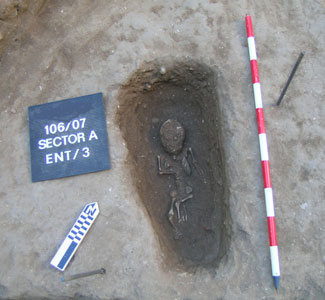Measuring the pubis: new parameters to date osseous remains

Growth studies are central to the accurate reconstruction of demographic profiles for past populations, and the reliable evaluation of age at death is core to the assessment and interpretation of many factors including indicators of health status and life conditions. However, in order to apply the development models to skeletal remains it is also important that the methodology be based on osteological material of documented biological identity (i.e. known sex, age and ethnic origin) to avoid inappropriate circular arguments relating to the establishment of methods derived from a dependent and inherent pre-existing age profile. In spite of the increasing necessity in Forensic Anthropology and Paleoanthropology to have a register of values on the development of all the skeletal elements, there is no data of growth based on direct measures. The main purpose of this paper is to bridge the gap in the literature through the analysis of the growth of the ischiopubic area of the innominate based on documented osteological material.
The innominate is the most important skeletal element in sex and age determination. In spite of the importance of having a record of growth values for all skeletal elements, there is not much information about the pre- and postnatal growth of the innominate or its elements (ilium, ischium and pubis). These few studies are based on discontinuous data coming from different stages of the life of the individual; consequently, the global vision is lost. In fact, to conduct morphometric studies of the innominate across all ages was not possible because of the fusion of its three elements during development. This makes following a linear analysis from birth to old age difficult. The solution is the use of a reference point that should be easy to locate both in young and adult bone. This reference is the anatomical acetabular point (point of union of the three elements).
The main contribution of our study is the definition of the anatomical acetabular point and its application to the innominate growth study form birth to old ages. In this paper 5 variables of the ischiopubic area were analysed (pubis length, ischiopubic index, vertical and horizontal diameter of the pubic articular area and the pubic acetabular index) by polynomial regression. The material used comes from four documented skeletal Western European collections: UAB collection , St Bride collection from England, and Coimbra and Lisbon collection from Portugal. None of the curves showed lineal growth, with the exception of the ischiopubic index and the masculine vertical diameter of the pubis acetabular area. Pubis length has the most complicated growth, expressed by a five-degree polynomial. For age estimation the best variables, in both archaeological and forensic remains, are the absolute measurements. However, pubis length is the best variable for age estimation because it can be applied until 25 years of age.
References
Rissech C i Malgosa A. 2007. Pubis growth study: Applicability in sexual and age diagnostic. Forensic Science International, 173:137-145.


